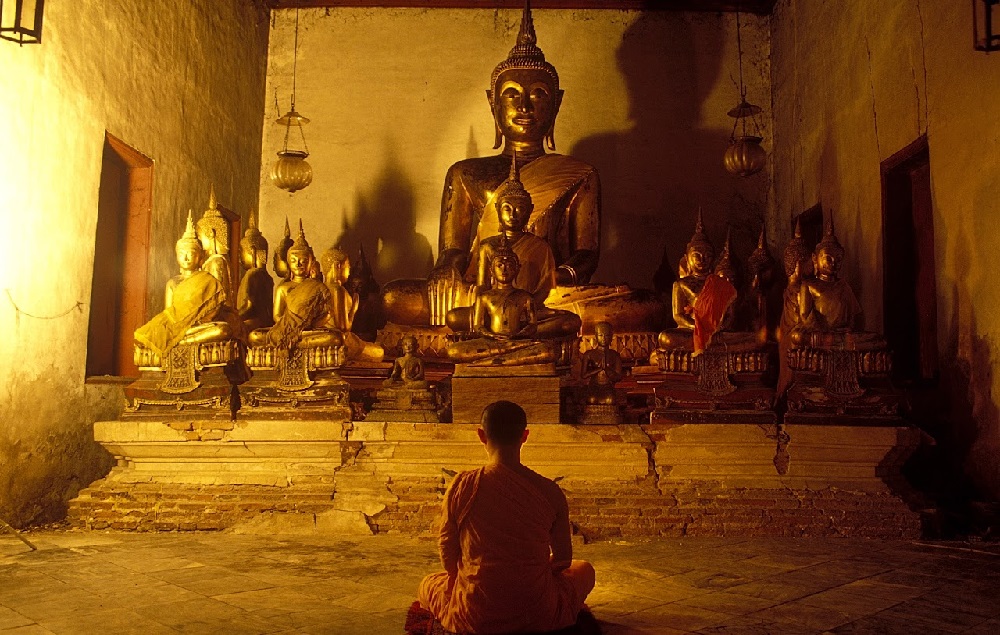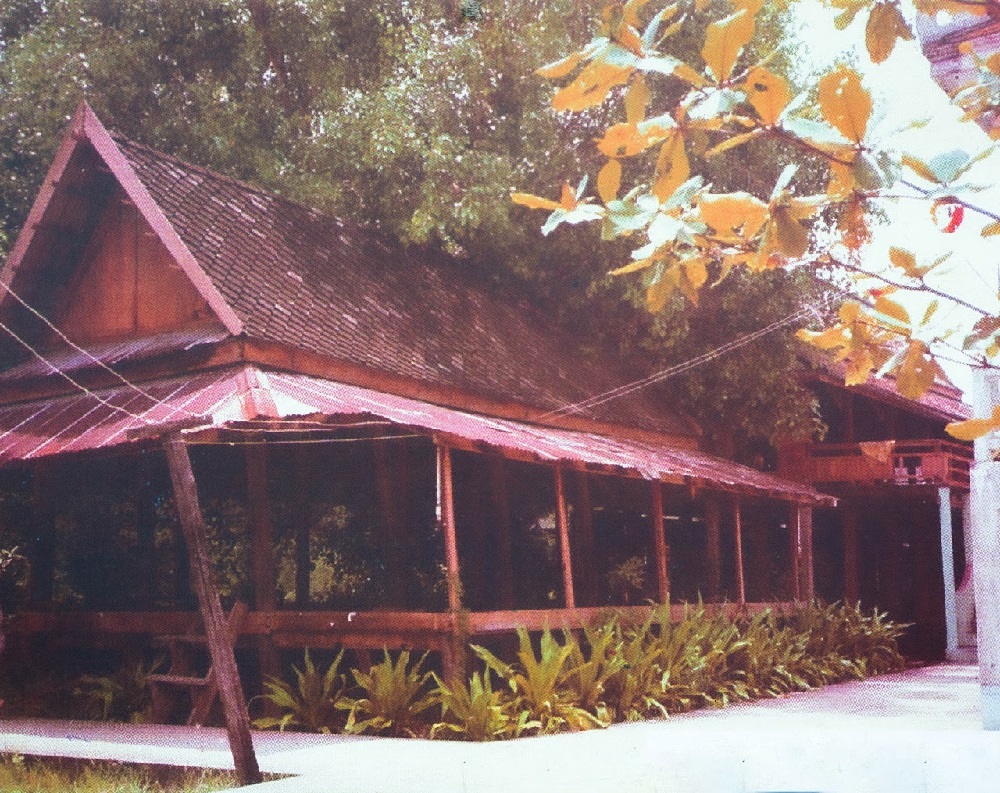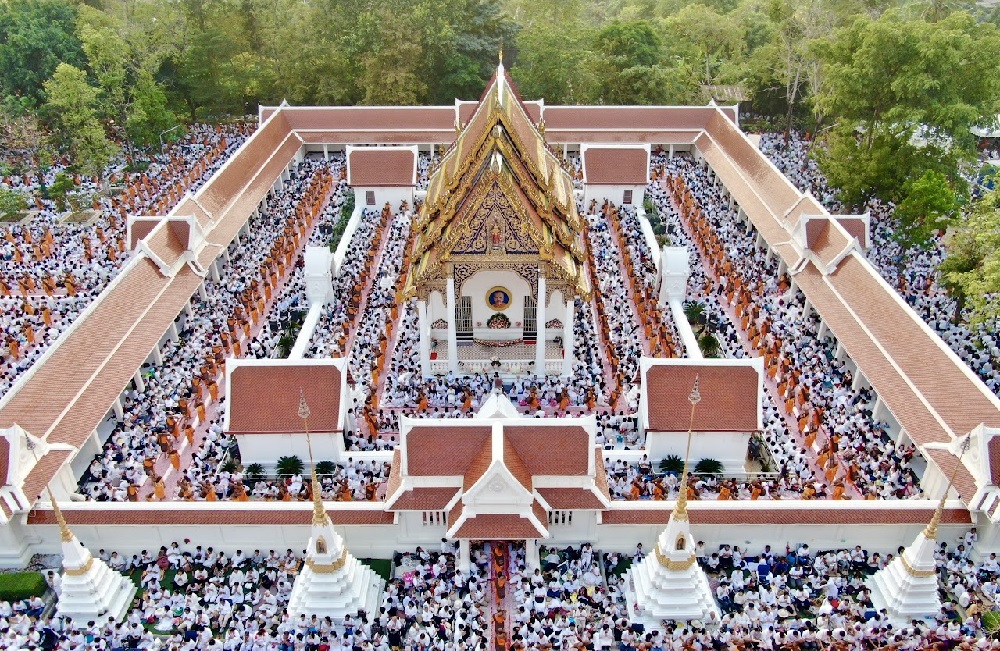
mediate at Wat Bote-bon
One morning as he was about to enter the rains retreat at Wat Bote-bon, he reflected on the fact that he had been ordained for eleven long years but still had yet to taste the ultimate Dhamma realized by the Lord Buddha. He determined to put forth all his energy to meditation that day until he attained even a small portion of the Truth. After completing his alms round and finishing his daily duties that morning he proceeded to the main chapel to meditate. He made up his mind to sit unmoved in his meditation until the midday drum sounded.
It was about eight in the morning on the full moon day of the tenth lunar month of the year 1917 when he sat down to meditate. Sitting in the half lotus position in front of the Buddha statue at the shrine hall, he closed his eyes and recited the mantra 'samma arahang, sammaarahang', quietly in his mind. Before long, pain began to develop throughout his body. Time passed awfully slowly. The pain became so excruciating that he felt as if every bone in his body was about to explode.
He was agitated.
"I have never felt such pain before. Why, now that I have sworn to sit unmoved in this position, is the pain so much more intense than I had ever felt? How much longer must I endure this suffering before the eleven o'clock drum sounds?"
He wanted to give up many times, but his fighting-spirit told him to persevere. He knew that an agitated mind was a hindrance to meditation, and he did his best to ignore the pain. After a couple of hours, right before the midday drum sounded, his mind finally began to settle. As his mind became more and more still, a bright sphere the size of an egg yolk appeared at the center of his body. It was so beautiful and soothing like nothing he had ever seen before. The pain mysteriously disappeared. And his agitation went away. Instead, he experienced a wonderful feeling of tranquility and bliss. He knew then that he was reaching the beginning state of spiritual attainment.
Then he heard the eleven o'clock drum, signaling time for the midday meal. Even as he was taking his meal the bright sphere continued to appear at the center of his body. It gave him a nice feeling of security and satisfaction. That day, even the midday meal tasted extraordinarily delicious. The tranquility and bliss that he felt reminded him of the Buddha's remark, "Natthi santi param sukham" (There is no higher happiness than peace itself). He was so overjoyed with the experience that a smile appeared on his face. The smile on Candasaro's face did not escape the notice of his fellow monks. They asked him why he was so cheerful. To which he replied, "I'm so touched by the wisdom of our Lord that I couldn't
help but smile."
That afternoon, after finishing the Patimokkha chanting along with other monks, Candasaro proceeded to the main chapel to meditate. Sitting in front of the Buddha statue, he declared:
"Upon this sitting, if I cannot attain even a small part of the ultimate Dhamma realized by the Lord Buddha, then I shall sit unmoved in this spot ... or die in the attempt."
He pleaded to the Buddha:
"May the Most Exalted One show me compassion and grant me the least and easiest of thy Enlightened Knowledge. Should my attainment of thy Enlightened Knowledge bring harm to Buddhism, don't grant it to me; but if it can benefit Buddhism, then, O Lord, please grant it to me. I shall be thy champion to uphold the greatness of thy Teachings until the last day of my life."
 Wat bote bon in past
Wat bote bon in past
Sitting in a half lotus position he began his deep meditation. It started to rain heavily. The atmosphere in the temple became damp. He saw a line of ants escaping from a crack in the floor. For a moment he thought that the ants might come and disturb his meditation, so he dipped his finger into a kerosene bottle nearby and began to draw a circle around himself to
prevent the ants from entering. But then he realized that he had just made a vow, willing to give up his life in pursuit of the Dhamma. Why then should he be afraid of these little ants? In self-disgust, he put the kerosene bottle away and set forth to meditate unprotected.
His mind began to settle as he meditated into the night. The bright, clear sphere that he saw earlier that morning reappeared and became even clearer and more radiant. As he meditated, the clarity of the sphere increased until it was as lucid as a flawless sphere of crystal. The brightness grew more intense until it outshined the midday sun. He contemplated on
this sphere for hours, from early in the evening until well after midnight, not knowing how to progress to the next level. (In all of his past meditation training there had been no master who had reached this level of experience, and therefore none of them would have been able to guide their students on how to deal with such a phenomenon.)
Candasaro focused his attention at the center of the bright sphere. Then, coming from the silence at the center of the sphere, there arose the gentle sound of the ancient words, 'majjhi-ma-patipada', a term from the ancient Pali meaning 'Middle Way'.
He thought to himself: "Ah... the 'Middle Way'! From my Scriptural study, we define this as 'a way of life which steers between the two extremes of asceticism and sensual indulgence'."

Wat Both-bon in present
But now this sound came directly from the center of his body. The center of the sphere was becoming inordinately bright as if it were the source of all the brightness in his body: bright, intense, cool and soothing. The illumination blazed so that the brightness increased enormously and deep in the brightness of the sphere he knew there existed something else. Then he started to realize that there must be a hidden meaning to the term 'Middle Way'. That tiny spot at the center of his body might, in fact, be the doorway to hidden inner dimensions.
He wondered:
"Could this in fact be the Middle Way? The tiny bright spot is right at the middle."
He then tried an experiment: contemplating deeper and deeper at the center of the bright spot. It started to expand until it reached the size of an egg yolk. Meanwhile, the former sphere also gained in size until it became so huge that it reached the horizons and then fadedaway. When he contemplated deeper at the center of the new sphere, another one appeared at its center. He continued this experiment, concentrating deeper at the center of each successive sphere. More and more spheres appeared-thousands of them, each one replacing the last as if shooting from a water fountain. As he meditated deeper, each new sphere was brighter and clearer than the last.
Going yet deeper he could see the transcendental nature of himself-the so-called "transcendental body"-a crystal clear inner body that resides within every human being. As his mind continued to be perfectly calm and still, several transcendental bodies appeared, one after another, each new one bigger, brighter, and more beautiful than the previous one. Until, finally, a supremely bright and pure image resembling that of the Buddha appeared. It is of the form of the Buddha sitting deep in meditation, the crest of his crown shaped like a lotusbud, an image brighter, clearer, more beautiful, and more marvelous than any Buddha image in the world.
This was 'Dhammakaya'-Body of Enlightenment.
Arriving at this stage of experience in meditation is called "attaining Dhammakaya".
Through this marvelous experience, Candasaro discovered that at the innermost part of every human being, there exists the seed of Enlightenment, the Buddha-nature-the potential to become a Buddha.
As he contemplated further, with a mind as bright and clear as a mirror, a voice echoed from the center of the Dhammakaya with these words: "This is right!"
Feeling elated, Candasaro muttered to himself:
"Ah, it is so hard like this... how could anybody perceive it? It is beyond perception, memory, thought, cognition. One would not attain it through these. Perception, memory, thought, cognition... all these things must come to a standstill and be united at one single point. Once the mind "stops", these things cease to be. Once they cease to be, attainment can be realized. This is the real thing. This is where the link is. Everything must come to the right point of balance before attainment can happen."
(Explanation: Once the mind stops wandering and comes to a standstill state, the hindrances which obstruct attainment will disappear. Once that happens attainment is possible. Later on, he came up with the maxim "Stop' is the key to success")

Wat Both-bon in present
As Candasaro continued to refine his inner experience for the next thirty minutes, an image of a familiar-looking temple appeared in his vision. He recognized it to be Wat Bang-pla, the temple he went to study at when he was eleven. He felt as if he was actually inside that temple. It appeared to him this could be a revelation that Wat Bang-pla was the first place his new found Dhammakaya Knowledge was to be propagated, and there would be individuals there to attain Dhammakaya following his footsteps.
From that day forward, Candasaro took the opportunity to go to Wat Bang-pla, accepting teaching engagements and supporting the ceremonies there until the end of the rains retreat. In the meantime he dedicated himself to refining and improving his newfound method of meditation-the Dhammakaya Meditation Method.
After the end of the rains retreat, he bade farewell to the abbot of Wat Bote-bon and moved to Wat Bang-pla permanently to teach meditation and the Dhamma. After four months, three monks (Venerable Sangvarn, Venerable Baen and Venerable Oam) and four laypeople attained Dhammakaya.
In his thirteenth rains retreat, Candasaro took with him all the monks who had attained Dhammakaya to Wat Songpinong, where they were to stay during the rains retreat, and teach Dhamma and meditation to monks and laypeople. By the end of the rains retreat, onemore monk attained Dhammakaya.
Soon after, Candasaro travelled to Wat Pratusamn, Suphanburi, where his preceptor, the (now) late Venerable Dee had once resided. He stayed there for four months to teach meditation and the Dhamma before returning to Wat Phra Chetuphon.